

In this Article
What are Professional Skin Lightening Treatments?
5 Benefits of Professional Skin Lightening Treatments?
3 Effective and Safe Skin Lightening Treatments?
5 Common Myths and Facts About Professional Skin Lightening Solutions?
6 Common Home Remedies for Skin Fairness?
Benefits of Skin Lightening Treatments at Home?
Facts about Body and Skin Lightening Treatment at Home
Professional Skin Lightening Treatments Vs. Home Remedies: Which is Better?
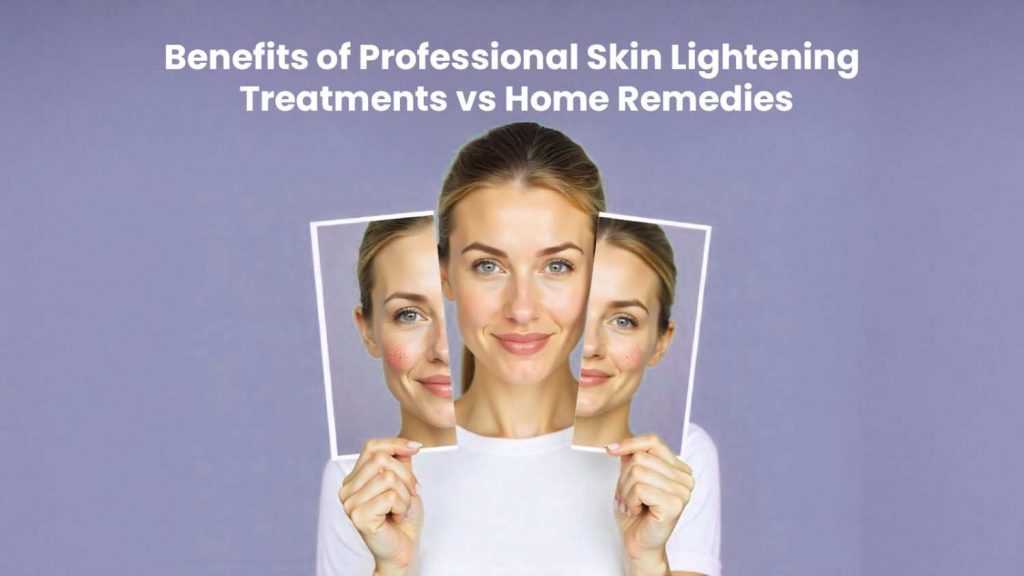
A Skin lightening treatment is often confused with delivering skin fairness. However, the primary goal of professional services or home remedies is to achieve radiant skin by reducing hyperpigmentation and fading the appearance of dark spots and uneven skin tone.
Every individual’s natural skin tone is beautiful, and changing it only reflects the amount of exploitation beauty standards have on our thought process. Now, to navigate more easily through the battle between home remedies and professional treatments, this blog is here to help. Read further to know more.
Professional-grade skin lightening treatments involve a range of dermatological practices that can control excess melanin production in the skin cells, leading to a more radiant, brighter and even-toned appearance. Such practices help address skin concerns like signs of ageing, sun damage-induced dark spots, post-acne marks and hyperpigmentation, helping restore the skin’s natural radiance.
Skin lightening and whitening treatments help you achieve more than just a radiant and clearer complexion; they also boost your confidence. Know more about professional skin lightening benefits through the following points:
While there is a range of skin lightening treatments available across the cosmetology and esthetician world, some of the most popular and safe treatment options are marked below:
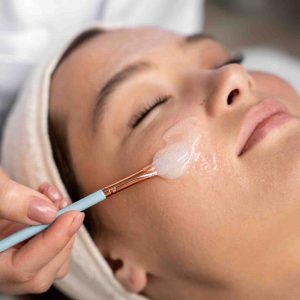
A chemical solution of salicylic acid or glycolic acid exfoliates the epidermis, the outer layer of the skin, revealing a more radiant and smoother complexion. These chemical peeling solutions work exceptionally well for skin concerns like melasma, post-acne hyperpigmentation and superficial acne scars.
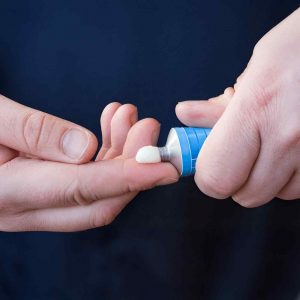
Skin lightening ingredients in OTC (Over the Counter) creams and serums, like azelaic acid, kojic acid, hydroquinone, or vitamin C, can help even skin tone and minimise the appearance of hyperpigmentation. While these are readily available at drugstores, they must be used under a doctor’s supervision to avoid possible side effects. One should apply it directly to the affected areas across the face and body.
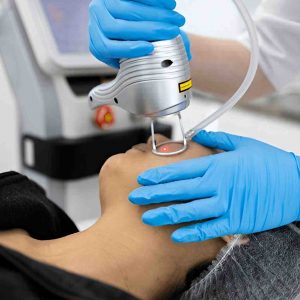
Professional laser therapies at renowned clinics use advanced lasers like the Q-switched laser, which precisely and effectively target and disintegrate melanin deposits in the skin, thereby fading dark spots, the appearance of melasma, and other hyperpigmentation issues.
While the skin lightening and brightening treatments help in restoring the skin’s lost radiance, some myths may discourage you from achieving clear, bright skin. Read to know more:
Fact: Similar to other skincare products in your daily routine, skin brightening topical solutions take time to show results. No such topical creams or serums can work overnight. Consistently using the prescribed solutions in the recommended amount and application method will start showing results in a few weeks or months.
Fact: Skin lightening treatments are not limited to any specific skin tone. Even light-toned people can get dark spots and hyperpigmentation because of factors like sun damage and acne marks. Hence, these professional procedures help people of all skin tones to minimise the appearance of dark patches and sun damage spots.
Fact: Common chemicals used for skin brightening include kojic acid, azelaic acid, and hydroquinone, which well-established dermatological clinics use in safe concentrations. However, overuse of these chemicals can cause skin sensitivity and irritation; hence, seeking professional service is significant.
Fact: There’s no such thing as ‘permanent skin lightening treatment’ as the results obtained from these procedures can last only a few months or years, depending on the treatment type and the patient’s skin type. Maintenance is essential to retain the outcomes.
Fact: No, firstly, any individual can benefit from skin whitening treatments irrespective of their gender. Secondly, the cost of such procedures is based on the intensity of the individual’s skin condition, the professional service provider, the type of treatment, and the location. Topical solutions are often relatively less expensive than laser therapies.

Home remedies for skin lightening comprise a few common kitchen ingredients like gram flour, turmeric, lemon, yoghurt, rice water and papaya. Here are 6 of the relevant skin whitening remedies at home that one seeking a ‘natural fix’ can check:
Home remedies for skin whitening are popular in Asian households for the following benefits:
Most of the ingredients found in home remedies are found in every Indian kitchen or local grocery stores. Natural ingredients are budget-friendly, making them a viable option for many.
Natural home remedies are gentler on the skin as they are free from any harsh chemicals. This builds trust among many individuals by familiarising them with skincare regimes.
Unlike commercial skin lightening services, home remedies do not require monthly or yearly maintenance. Using them for a certain period in the correct method can reveal sustainable results.
‘Natural ways are always safe,’ but is it? Take a look at these facts about body and skin lightening treatment at home that clinical experts highlight:
Explanation: While ingredients like yoghurt, turmeric and lemon may be budget-friendly options and offer temporary radiant-like results, they don’t penetrate deep into the skin to reverse melanin-induced hyperpigmentation.
Explanation: Professional skin lightening therapies use scientifically tested and clinically proven ingredients (in safer concentrations) and technology that provides sustainable and reliable results by targeting pigmentation at the root.
Explanation: Ingredients like lemon juice or baking soda can irritate the skin, strip the natural oils, disrupt the skin barrier, and even cause burns, hence worsening pigmentation in the applied areas. Falling for home remedy propaganda can prove harmful for sensitive skin.
If you are experiencing the side effects of home remedies and seeking professional guidance for spotless and radiant skin, booking an appointment at Wizderm will be a smart, trusted step. At Wizderm, experienced dermatologists offer personalised skin lightening treatments tailored to your unique skin type, concerns, and budget.
Instead of superficial fixes, you will receive a detailed skin analysis and a customised treatment plan designed to deliver safer, longer-lasting results. Check this out to learn more about our professional skin lightening procedures.
While home remedies may seem affordable and harmless, they can be quite ineffective when it comes to outcomes and may even heighten irritation and allergies for sensitive skin. Professional skin lightening services at Wizderm are science-backed, dermatologist-led, and customised to your unique skin needs.
Take a step towards a clearer, brighter complexion and sustainable skin health without the guesswork. Book an appointment online today to connect with top experts across India!
Yes, skin lightening treatments are safe for all skin types, including sensitive skin, if availed from a trusted and well-established, dermatologist-led clinic like Wizderm.
Noticeable results depend mainly on the type of professional treatment availed for skin lightening. For treatments like a hydra facial or mild chemical peels, one can see visible differences in their skin tone instantly. However, topical or oral treatments, or laser therapies have a greater downtime (cooling period), and can show positive changes eventually.
No, there are no side effects of laser skin lightening procedures at Wizderm. Also, how one’s skin reacts to different types of procedures depends on their skin type and the type of treatment. Having said this, one may feel a slight tingling or burning sensation if their skin comes in contact with strong acids or laser light. Importantly, these skin reactions are temporary; however, one should use a cold compress if the redness and inflammation are concerning.
Skin lightening treatment cost in India ranges between Rs. 1,800 to Rs. 5,500 for chemical peels, while for laser treatments, it costs somewhere between Rs. 6,000 to Rs. 40,000. At Wizderm, the cost for chemical peels starts from Rs. 3,000 and ends at up to Rs. 50,000 for cosmelan treatments.
Yes, at Wizderm, clinical experts recommend a combination of skin lightening treatments with other dermatological procedures for better results. For example, a doctor may suggest topical creams with chemical peels for someone battling with hyperpigmentation for issues like inflammation, hormonal changes and sun damage.
Clinical treatments for skin lightening are gender neutral, enabling even men to target the root cause of hyperpigmentation and uneven skin tone, to reveal a brighter and healthier complexion.
In this Article
What is hormonal acne? How can you prevent it?
What are the root causes of hormonal acne?
What does hormonal acne look like?
Hormonal acne vs fungal acne: What’s the difference?
How to prevent and control hormonal acne?
Prescription oral treatments and cosmetic procedures
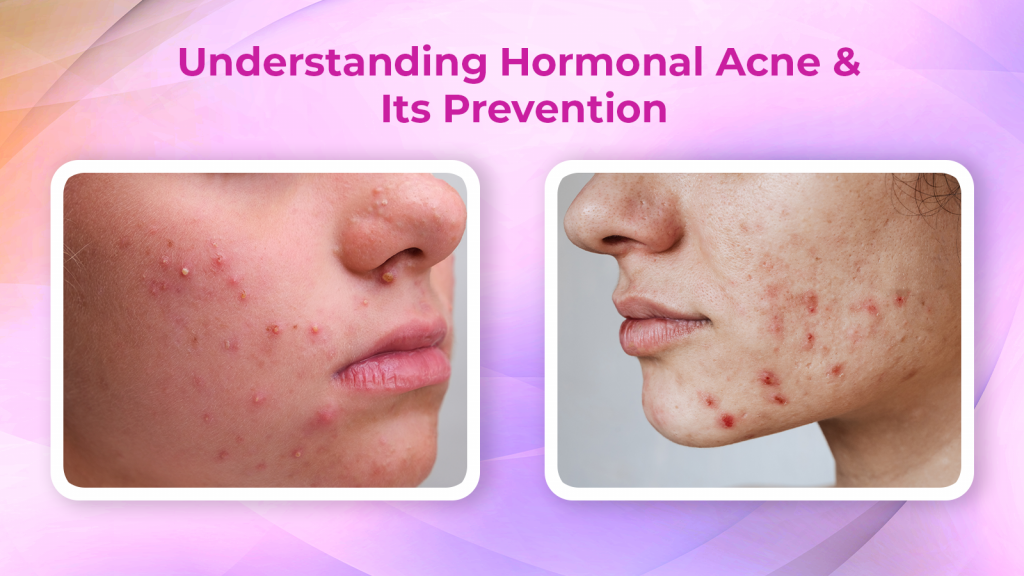
The thought of painful, inflamed and pus-filled acne breakouts can instantly gross somebody out. These enormous-looking pimples are called ‘hormonal acne’, which can result from a combination of reasons like insulin spikes, high cortisol levels, puberty, poor diet, and lack of physical activity.
The major cause of these lesions is hormonal fluctuations. While all of these may sound baffling, this blog emphasises what hormonal acne is, what causes it, and how to prevent it with natural remedies and medical treatments. Read to know more.

Reviewed by Dr. Swarnali Maiti
MBBS, MD in Dermatology, Venerelogy & Leprosy
Updated on: July 5, 2025
Hormonal acne, or commonly known as adult acne, is directly caused by the presence of excess sebaceous (oil) glands, and is commonly found to affect men and women between the ages of 20 and 50. The blockage of pores caused by sebum, dirt or product buildup can cause acne.
Hormonal acne could cause bumps on an individual’s face, chest, shoulders, and back in the form of cysts, pimples, whiteheads and blackheads. It is to be noted that hormonal imbalance acne is more common in women than in men, research showing that approximately 80.9% of women are predominantly affected when compared to the 19.1% of male adult acne patients.
Firstly, it is to be noted that hormonal acne patients experience more breakouts in the following phases:
To understand which hormones play a role in causing acne, researchers surmise that the hormone androgen can be linked to the condition. While androgens are found in both males and females, the concentration is lower in case of women. The presence of excess androgens in women causes the oil glands to produce uncontrollably more sebum than usual, hence, inducing acne flare-ups.
Thereafter, the level of androgen (the hormone that causes acne in females) in the body can increase because of the following factors:
Nonetheless, androgen hormone levels in the body (both men and women) can also increase due to poor dietary choices such as dairy, gluten and sugar.
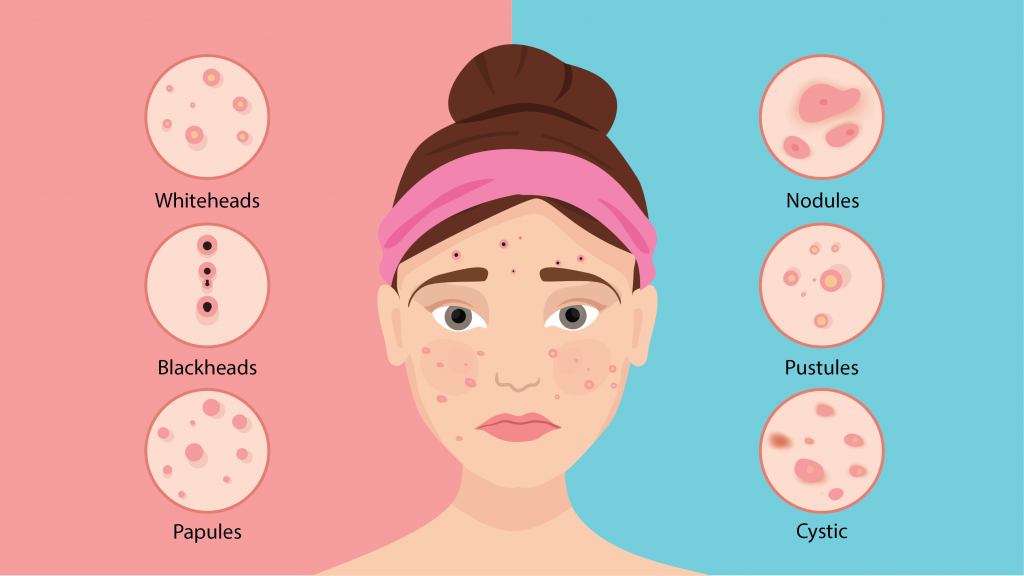
Hormonal acne symptoms can manifest as painful, deeper papules, pustules, cysts and nodules on one’s lower cheeks, jawline and chin. Some signs can also occur as non-itchy whiteheads and blackheads. These damaged skin tissues or lesions can appear red, be filled with pus and even feel sore just by the thought of touching the affected area.
Besides one’s face, neck, back, chest, and shoulders are other common areas where hormonal acne may occur. Picking at the blemishes or squeezing them can worsen the condition, transferring the germ to other nearby areas.
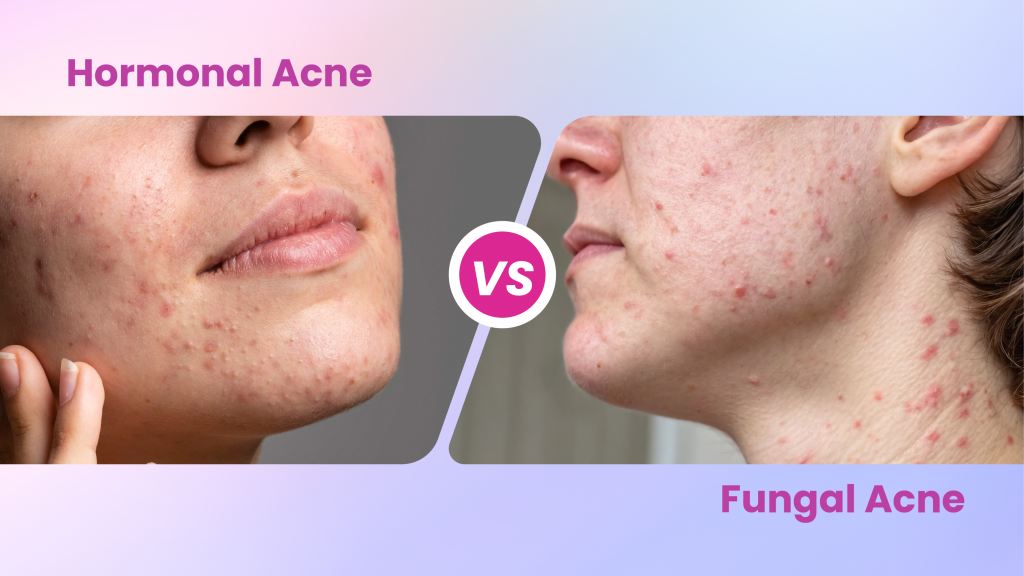
Hormonal imbalance acne may often be mistaken for fungal acne, as both occur in the hair follicles; however, they have distinctive characteristics. Hormonal imbalances lead to the production of excess sebum, hence causing clogged pores and hormonal acne.
On the other hand, the overdevelopment of Malassezia yeast on the skin impacts the hair follicles and results in a cluster of small, often with red borders, uniform, itchy bumps on the forehead, chin, cheeks, upper back, shoulders and chest.
Antifungal treatments are ideal for managing fungal acne, whereas hormonal acne responds well to targeted sebum-regulating treatments.
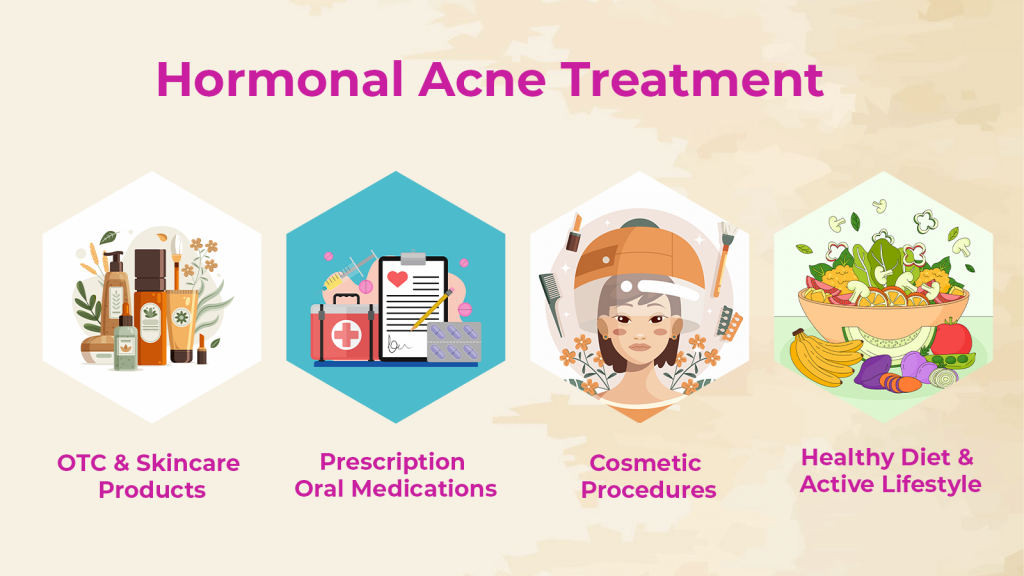
The treatment of adult acne involves a combination of natural and medical fixes. While using topical creams may reduce sebum production and inflammation of lesions, it is essential to fix hormonal fluctuations from within as well.
Take a look at the following hormonal acne remedies that a professional may recommend based on the severity of the acne:
Retinoids belong to the family of Vitamin A derivatives, which can help treat skin conditions like psoriasis and acne, reduce the appearance of signs of ageing, and improve skin texture.
Mild to moderate acne can be treated well with these OTC retinoids:
While these retinoids are easily available at pharmacies, it is paramount to consult with a doctor before using them to avoid potential skin complications. Also, these hormonal acne creams can come in the form of gel or cream, and should be applied strictly in the evening.
Commonly used skincare actives like salicylic acid and benzoyl peroxide are other relevant topical hormonal acne treatments. One can use a foaming salicylic acid face wash daily twice in the morning and evening, while using a benzoyl peroxide gel in the evening after cleansing, followed by a non-comedogenic face cream.
Oral antibiotics, including doxycycline, tetracycline and minocycline, can help reduce the inflammation and redness caused by pustule or cystic acne. Another potent oral medication for preventing and controlling hormonal acne includes isotretinoin.
Isotretinoin (Accutane) is a strong retinoid which is often suggested as a last-resort treatment option by professionals for patients with moderate to severe and persistent hormonal cystic acne. It functions by controlling sebum production, reducing inflammation and preventing clogging of hair follicles.
Anti-androgen drugs like spironolactone stabilise the hormone receptors, regulating the androgen count in females. This prevents the hormone from affecting hair follicles and increasing sebum.
Contraceptive (birth control) pills containing ethinyl estradiol, norethindrone, drospirenone and norgestimate together can block the androgen hormone, causing adult acne, and especially benefit women during the ovulation phase in their menstrual cycle.
Other anti-androgen medications include ingredients like cyproterone and metformin, which can help regulate hormonal fluctuations and control acne.
A non-invasive, dermatological acne treatment that uses a safe chemical solution chemically formulated to exfoliate the skin on a deeper level. This exfoliation helps unclog pores, hence preventing breakouts and even ensuring a smoother, clearer complexion. Professional-grade chemical peels also relieve patients from acne inflammation.
Laser treatment is an ideal choice for individuals seeking drug-free treatment. It works by targeting sebum glands, shrinking them and reducing excess oil, hence preventing clogging of pores. It also helps calm hormonal acne-related inflammation and further reduces the appearance of post-acne dark spots.
Hormonal acne diet involves specific food choices that can help reduce acne-related inflammation, manage insulin spikes, and stabilise blood sugar levels. Let’s take a look at the food that one can include to regulate hormonal fluctuations:
Berries, nuts, sardines, salmon, chia seeds, walnuts, flaxseeds and leafy greens reduce oxidative stress and promote skin health.
Opt for brown rice, whole wheat and quinoa over refined carbs to avoid an insulin spike. Similarly, choose good sources of fibre like beans and legumes to control blood sugar.
Almond milk, soy milk, and oat milk are excellent alternatives to cow milk and can help prevent hormonal acne flare-ups.
Apples, plums, papayas, and grapes should be included in the diet to limit the consumption of sugary fruits.
Besan chila, chicken salad, or an oats bowl in the morning can help regulate blood sugar and contribute to healthy skin.
If hormonal acne persists even after using topical creams, following a healthy lifestyle and consuming a hormonal acne-friendly diet, seek professional advice from a reputable dermatologist. At Wizderm, our expert team of doctors offer a detailed skin analysis, helping you understand the root causes of acne and offer appropriate and customised treatment plans. Book your consultation today at Wizderm Skin and Hair Clinic!
Yes, hormonal acne is also called ‘adult acne’, as it mainly affects men and women between the ages of 20 and 50, specifically after hitting puberty.
No, hormonal acne can show up on one’s face (lower cheeks, chin and jawline), shoulders, back and even chest.
While stress is one of the major triggering factors of hormonal acne, flare-ups can also be caused due to an increase in androgen hormones in the body, a diet rich in high glycemic foods and dairy, and a lack of involvement in physical activity.
The speed at which outcomes show up depends on the individual’s skin type, severity of the acne lesions and the treatment type. However, topical treatments can take up to 6 – 8 weeks to show visible changes with consistent use, while clinical procedures, such as chemical peels, can yield results much faster, often in just a few sessions.
Yes, hormonal acne can affect both men and women, and treatments are available for both genders.
Absolutely not! Popping or picking at the hormonal acne cysts can cause transfer of the bacteria or oil across the nearby areas and lead to further breakouts.
Yes, dairy and sugar can worsen hormonal acne by increasing androgen and insulin levels, thereby boosting sebum production and inflammation. This, therefore, leads to more breakouts.
Yes, it is very likely to treat mild to moderate hormonal acne with only topical retinoids, chemical peels, healthy lifestyle habits, and dietary tweaks, eliminating the need to consume medications.
Yes, birth control pills regulate the androgen hormones that trigger acne in women, reducing breakouts and inflammation. However, one must strictly consult with a doctor about its usage, especially if the acne condition is moderate to severe.
Registered Office
Wizderm Speciality Skin & Hair Clinic 1/503, Gariahat Road, Jodhpur Park, Kolkata, West Bengal 700068
Mon - Sat: 10 AM - 8 PM
© 2025 Wizderm Speciality Skin & Hair Clinic. All rights reserved.
Crafted with by Auraveni Solutions.
Stay updated with expert tips, latest treatments, and exclusive offers. Subscribe to Wizderm's newsletter for healthy, glowing skin and hair!